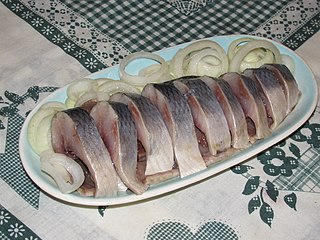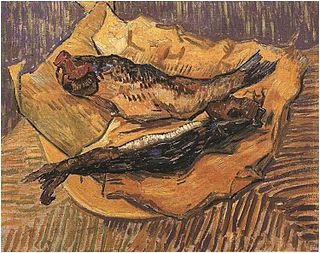
A kipper is a whole herring, a small, oily fish, that has been split in a butterfly fashion from tail to head along the dorsal ridge, gutted, salted or pickled, and cold-smoked over smouldering wood chips.

Salting is the preservation of food with dry edible salt. It is related to pickling in general and more specifically to brining also known as fermenting and is one form of curing. It is one of the oldest methods of preserving food, and two historically significant salt-cured foods are salted fish and salt-cured meat. Vegetables such as runner beans and cabbage are also often preserved in this manner.

Dutch cuisine is formed from the cooking traditions and practices of the Netherlands. The country's cuisine is shaped by its location on the fertile Rhine–Meuse–Scheldt delta on the European Plain bordering the North Sea, giving rise to fishing, farming, and overseas trade. Due to the availability of water and flat grassland, the Dutch diet contains many dairy products such as cheese and butter, and is relatively high in carbohydrates and fat.

Pickled herring is a traditional way of preserving herring as food by pickling or curing.

Soused herring is raw herring soaked in a mild preserving liquid. It can be raw herring in a mild vinegar pickle or Dutch brined herring. As well as vinegar, the marinade might contain cider, wine or tea, sugar, herbs, spices, and chopped onion.
Norwegian cuisine in its traditional form is based largely on the raw materials readily available in Norway and its mountains, wilderness, and coast. It differs in many respects from continental cuisine through the stronger focus on game and fish. Many of the traditional dishes are the result of using conserved materials, necessary because of the long winters.

Smoked fish is fish that has been cured by smoking. Foods have been smoked by humans throughout history. Originally this was done as a preservative. In more recent times fish is readily preserved by refrigeration and freezing and the smoking of fish is generally done for the unique taste and flavour imparted by the smoking process.

Fresh fish rapidly deteriorates unless some way can be found to preserve it. Drying is a method of food preservation that works by removing water from the food, which inhibits the growth of microorganisms. Open air drying using sun and wind has been practiced since ancient times to preserve food. Water is usually removed by evaporation but, in the case of freeze-drying, food is first frozen and then the water is removed by sublimation. Bacteria, yeasts and molds need the water in the food to grow, and drying effectively prevents them from surviving in the food.

Cured fish is fish which has been cured by subjecting it to fermentation, pickling, smoking, or some combination of these before it is eaten. These food preservation processes can include adding salt, nitrates, nitrite or sugar, can involve smoking and flavoring the fish, and may include cooking it. The earliest form of curing fish was dehydration. Other methods, such as smoking fish or salt-curing also go back for thousands of years. The term "cure" is derived from the Latin curare, meaning to take care of. It was first recorded in reference to fish in 1743.

Salted fish, such as kippered herring or dried and salted cod, is fish cured with dry salt and thus preserved for later eating. Drying or salting, either with dry salt or with brine, was the only widely available method of preserving fish until the 19th century. Dried fish and salted fish are a staple of diets in the Caribbean, West Africa, North Africa, South Asia, Southeast Asia, Southern China, Scandinavia, parts of Canada including Newfoundland, coastal Russia, and in the Arctic. Like other salt-cured meats, it provides preserved animal protein even in the absence of refrigeration.

Bokkoms is whole, salted and dried mullet, and is a well-known delicacy from the West Coast region of South Africa. This salted fish is dried in the sun and wind and is eaten after peeling off the skin. In some cases it is also smoked. It is sometimes referred to as "fish biltong".

Fish preservation is the method of increasing the shelf life of fish and other fish products by applying the principles of different branches of science in order to keep the fish, after it has landed, in a condition wholesome and fit for human consumption. Ancient methods of preserving fish included drying, salting, pickling and smoking. All of these techniques are still used today but the more modern techniques of freezing and canning have taken on a large importance.

A herring buss was a type of seagoing fishing vessel, mostly used by Dutch and Flemish herring fishermen in the 15th through early 19th centuries.

Bloaters are a type of whole cold-smoked herring. Bloaters are "salted and lightly smoked without gutting, giving a characteristic slightly gamey flavour" and are particularly associated with Great Yarmouth, England. Popular in the 19th and early 20th centuries, the food is now described as rare. Bloaters are sometimes called a Yarmouth bloater, although production of the product in Yarmouth appears to have now ceased in the town with the closure of its smoked fish factory in 2018. The bloater is also sometimes jokingly referred to as a Yarmouth capon, two-eyed steak, or Billingsgate pheasant.

Surströmming is lightly salted, fermented Baltic Sea herring traditional to Swedish cuisine since at least the 16th century. It is distinct from fried or pickled herring.

Herring are forage fish in the wild, mostly belonging to the family Clupeidae. They are an important food for humans. Herring often move in large schools around fishing banks and near the coast. The most abundant and commercially important species belong to the genus Clupea, found particularly in shallow, temperate waters of the North Pacific and North Atlantic Oceans, including the Baltic Sea, as well as off the west coast of South America. Three species of Clupea are recognized; the main taxon, the Atlantic herring, accounts for over half the world's commercial capture of herrings.

Anchovies are small, common saltwater forage fish in the family Engraulidae that are used as human food and fish bait. There are 144 species in 17 genera found in the Atlantic, Indian, and Pacific Oceans. Anchovies are usually classified as oily fish. They are small, green fish with blue reflections due to a silver longitudinal stripe that runs from the base of the caudal fin. They range from 2 centimetres (0.79 in) to 40 centimetres (16 in) in adult length, and the body shape is variable, with more slender fish in northern populations.

Canned or tinned fish are food fish which have been processed, sealed in an airtight container such as a sealed tin can, and subjected to heat. Canning is a method of preserving food, and provides a typical shelf life ranging from one to five years. They are usually opened via a can opener, but sometimes have a pull-tab so that they can be opened by hand. In the past it was common for many cans to have a key that would be turned to peel the lid of the tin off; most predominately sardines, among others.

William Buckels, also known as Willem Beuckel, Willem Beuckelsz or William Buckelsson, and sometimes Willem Beuckelszoon by the Dutch, was a 14th-century fisherman from Biervliet, Zeeland, whose discovery of gibbing, a preservation process for herring, led to the Dutch becoming a maritime power.






















